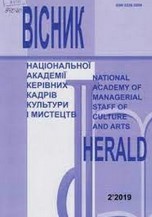ІНТЕРТЕКСТУАЛЬНІ АСПЕКТИ ПОСТАНОВОК УКРАЇНСЬКОЇ НАРОДНО-СЦЕНІЧНОЇ ХОРЕОГРАФІЇ
INTERTEXTUAL ASPECTS OF PRODUCTIONS OF UKRAINIAN FOLK-STAGE CHOREOGRAPHY
Author(s): Dar’ya DegtyarSubject(s): Theatre, Dance, Performing Arts, Customs / Folklore, Cultural Anthropology / Ethnology
Published by: Національна академія керівних кадрів культури і мистецтв
Keywords: Improvisation; dance improvisation; improvisation in choreography; dance;
Summary/Abstract: The purpose of the article is to reveal the specificity of intertextuality in the choreographic text of Ukrainian folk stage dance productions. The research methodology is determined by the complexity and multifacetedness of the production of folk stage choreography as an artistic work and is represented by a combination of various research approaches, namely interdisciplinary, systemic, and cultural. The purpose of the study led to the use of comparative, structural-semiotic, hermeneutic, and intertextual analysis methods widely adapted in modern humanitarian science, the main principle of which is to consider the choreographic text as an open system that enters into various relationships with other systems. Intertextual analysis plays an important role in revealing the concept of a choreographic work, its relevance is based on the idea of dialogic essence and continuity of culture. Scientific novelty. The performance of folk stage choreography is studied through the prism of the concept of intertextuality of Yu. Kristeva and theoretical approaches to the study of the text of R. Barthes; the role of the choreographer-director and the audience in the context of the creation and interpretation of the choreographic text is considered; the concept of “intertextuality” in the context of the choreographic text of the production of folk stage choreography is clarified; it was found that the character of intertextuality directly depends on the specifics of communication, which is determined by the nature of the choreographic text of folk-stage forms. Conclusions. As a result of the extrapolation of Yu. Kristeva's concept of intertextuality and theoretical approaches to the study of R. Barth's text to folk-stage choreography, it was found that: the choreographic text of a folk-stage performance is created by means of synthesising various quotes that refer to a variety of cultural sources; in the multidimensional space of the folk stage production, the process of systematic birth of meaning and its release takes place; the concept of intertextuality in the context of the production of folk stage choreography blurs the contours of the choreographic text, turning it into an infinite artistic dimension of connections and associations. The conducted analysis allows us to define the phenomenon of intertextuality of folk-stage choreography performances as a special choreographic intertextual space, in the middle of which there is accumulation, coexistence and constant interaction of all the diversity of vocabulary of authentic and folk-stage dance. In its middle, any element of a folk dance is immersed in a general cultural context and correlates with an array of other choreographic texts, multiplying its own content, relevance and interpretive possibilities. Intertextual interactions in the choreographic text of a folk-stage dance provide an opportunity for the choreographer director to enter the continuum of eternal themes of folk culture, enter into an artistic dialogue with the past achievements of dance culture and, thus, reflect their own vision of the scene-content part of the folk-stage dance, which, in turn, expands the figurative system of the new choreographic work, emphasises its multi-layeredness and serves as a basis for various interpretations. The choreographerproducer of the folk stage dance interacts not only with the reality surrounding them, but also with the entire corpus of their previous and contemporary choreographic works, and most importantly with folk dance primary sources, being in a state of permanent dialogue with them. The text of a folk stage choreographic production consists of various elements that come from different cultures, enter into a relationship of dialogue, parody, discussion with each other – all this multiplicity is focused in a certain point, which is the viewer. The viewer’s role in the interpretation of the choreographic text is crucial, as their previous experience, cultural and educational background will undoubtedly influence the amount of meaning they can obtain when viewing the choreographic work. Accordingly, the choreographic text acquires unity not in its origin, but in its purpose. The analysis of the manifestation of intertextuality as one of the fundamental techniques in the productions of folk stage choreography requires considering them as works that consist of texts that are actualised in a specific semiotic context and contribute to the preservation of Ukrainian folk dance culture in particular and the cultural memory of Ukrainians in general.
Journal: Вісник Національної академії керівних кадрів культури і мистецтв
- Issue Year: 2022
- Issue No: 3
- Page Range: 156-161
- Page Count: 6
- Language: Ukrainian

